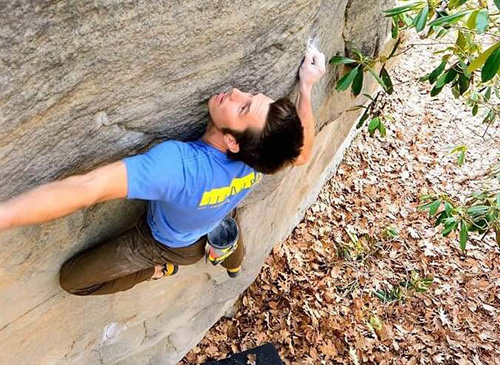Jessica Menold, assistant professor of engineering design, pours silicone into molds to create earpieces for disposable stethoscopes. (IMAGE: JESSICA MENOLD)
This spring, as COVID-19 swept across the country, Tim Simpson used his expertise in 3D printing to bring together a group of collaborators to solve urgent problems related to the design and manufacturing and sterilization of personal protective equipment (PPE) for the pandemic.
Simpson is co-director of Penn State CIMP-3D, a world-class resource for advancing and deploying additive manufacturing (AM) technology. He’s also the director of a first-in-the-world grad program in additive manufacturing and design that is training over 120 professionals from 60 different companies all over the world to creatively solve problems with 3D printing.
So when the pandemic hit, that’s exactly what he did.
Step 1: AM students work on ideas to contain spread of COVID-19
Simpson initially created projects for his undergraduates to work on when Penn State’s classes moved online. But as he collaborated with top AM companies around the world, he started to hear stories of how additive manufacturing was being used to battle the coronavirus.
“Having my students make and test a bunch of random 3D printed parts on some material extrusion systems in an AM lab to quantify variability just did not seem important anymore,” he says. Besides, they didn’t have access to the AM lab anymore, anyway.
But while they didn’t have access to the lab, most of his students did have their own 3D printers, so he set them to work designing, developing and prototyping their own ideas to help contain the spread of coronavirus. They came up with ideas like hands-free door openers, phone booth-like plastic shields and keyboard and mouse covers for the student computer labs.
Step 2: Penn State’s 3D community jumps in to help
As Simpson started to share what his class was doing, the 3D network around Penn State wanted to know how they could help. He connected with Penn State’ College of Medicine at the Hershey Medical Center to find out about their immediate needs. Within days, hundreds of emails were sent, connections forged and a new endeavor was formed.
“Over the course of three weeks, we went from a five-person group to over 400 people on 21 different campuses. With all of these connections and offers to help, things came together very, very quickly,” he says.
Step 3: A team of 400 people collaborate to form MASC – and get busy
Within a few weeks, what had started as an idea for a class project had turned into a collaborative team of faculty, students, clinicians and doctors forming the Manufacturing and Sterilization for COVID-19, or MASC initiative. Collaborators came from all over within Penn State, as well as local manufacturing companies like Actuated Medical, Morgan Advanced Materials, Salimetrics and Xact Metal and the newly opened community maker-space, The Rivet at Discovery Space.
The team first worked on a 3D printed prototype for face shields. They used a design created and shared by PRUSA, an open source 3D printing company in the Czech Republic, and began to modify it to work for their needs. Some faculty members and engineers used their labs to organize operations, but most of the work has been done remotely due to stay-at-home orders from Gov. Tom Wolf. The rest of the team collaborated from their homes, using personal 3D printers to work as quickly as possible.
Step 4: Local manufacturers pivot to create PPEs
Within days, the team had modified the open design, and worked with the Penn State Applied Research Lab, making sure that they had the correct plastic, using laser cutting to finalize the face shield for the initial prototype.
Hershey Medical Center loved the effort and the result, and reached out to Universal Protective Packaging, Inc. (UPPI), a Harrisburg-based manufacturer that started producing thousands of face shields per day for the staff and patients at Hershey. Meanwhile, the team reached out to the Innovation Hubs at 21 of the 24 Penn State commonwealth campuses to ask for their help 3D-printing face shields that could be locally distributed within each community. Many had already engaged their local communities independently, and Simpson and his team helped them navigate the legal and regulatory landscape for medical devices and PPE.
In Happy Valley, medical supply company Actuated Medical answered the call early as well, pivoting from producing surgical instruments to manufacturing sturdy, breathable face shields that could be quickly distributed to first responders, teachers, athletes and even nursing home residents.
“These small nursing homes and local municipalities are not high on the prioritization list like giant hospitals,” Simpson said. “But these people need PPE just as badly.”
The Rivet worked with Actuated Medical to produce more than 300 face shields with its inventory of 3D printers and laser cutters.
Step 5: Continued collaboration to help stem the tide of COVID-19
“Collaboration has been critical to the success of MASC,” Simpson says. “Innovating in the manufacturing space as well as the sterilization space with experts at Penn State and beyond.”
In the months since the initial face shield project, MASC has worked on creating and manufacturing gowns, filtration masks and even single patient stethoscopes. Meanwhile, UPPI is getting ready to create and distribute their millionth face shield, helping to protect Pennsylvanians across the Commonwealth. And if the last few months are any indication, the collaboration and problem-solving is far from over.
“A lot of great partnerships and relationships came out of this for the team and for Penn State, in general,” Simpson says, adding, “I hope they last forever!”






